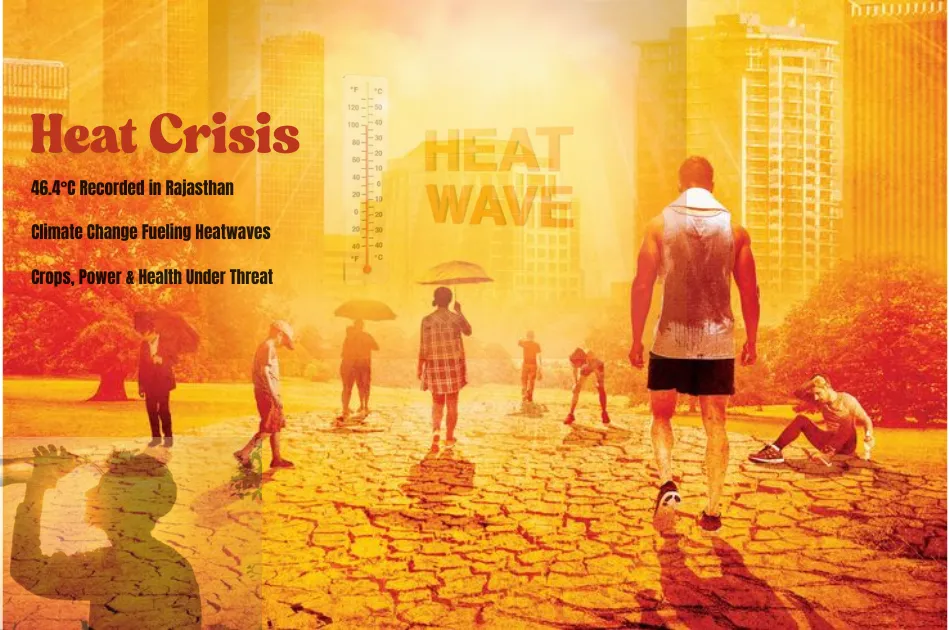- Admin
- Apr 24, 2025
- Heat Crisis
India-Pakistan Heatwave 2025: Causes, Effects, and Urgent Climate Action
India-Pakistan Heatwave 2025: A Record-Breaking Climate Crisis Threatening Lives and Livelihoods
Introduction
The summer of 2025 will be remembered as a turning point in South Asia's climate history. A record-breaking heatwave engulfed India and Pakistan, breaking temperature records, stressing infrastructure, disrupting agriculture, and endangering millions of lives. With temperatures in areas like Barmer, Rajasthan reaching 46.4°C (115.5°F) in early April, this extreme weather event drew global attention. What sets this heatwave apart is its early onset, signaling a major shift in regional climate trends. This article offers a comprehensive analysis of the 2025 heatwave, its far-reaching consequences, scientific context, and critical future implications.
Chapter 1: The Meteorological Unfolding
Unprecedented Temperatures
Cities across Rajasthan, Gujarat, Punjab, Sindh, and southern Pakistan recorded extreme highs, exceeding 44°C (111.2°F). What’s alarming is that such heat typically peaks in May or June, not April.
The Role of High-Pressure Systems
A stationary high-pressure system caused clear skies and intense solar radiation. Combined with delayed western disturbances, this weather setup led to record-setting day and night-time temperatures.
Forecasts and Alarms
Both the India Meteorological Department (IMD) and Pakistan Meteorological Department (PMD) issued alerts for an above-normal number of heatwave days, warning the public and advising precautionary measures.
Chapter 2: Human Toll and Public Health Crisis
Health Impacts
The intense heat led to a surge in cases of heat exhaustion, dehydration, and cardiovascular issues. Hospitals struggled to manage the increasing number of patients.
Most Vulnerable Groups
Daily-wage workers, children, the elderly, and those with existing health conditions faced the worst consequences. In cities, the urban heat island effect worsened heat exposure.
Emergency Measures
Governments launched cooling centers, hydration stations, and awareness campaigns. Yet, resource shortages hampered efforts, especially in rural zones.
Chapter 3: Infrastructure and Energy Systems Under Stress
Power Grid Overload
The intense heat caused a spike in electricity usage, leading to blackouts in parts of India and load-shedding across Pakistan’s major urban centers.
Transport and Construction Disruptions
Rail tracks warped, roads cracked, and airport operations were affected by tarmac softening. Daily mobility became a challenge.
Worsening Water Crisis
With increased evaporation and rising demand, water shortages intensified. Many areas resorted to rationing, while wells and reservoirs ran dry.
Chapter 4: Agricultural Devastation
Crop Losses
The heatwave hit during the critical rabi harvest. Key crops such as wheat, rice, mangoes, and cotton suffered major losses.
Economic Impact
Billions in damages are expected. With supply chains disrupted, food inflation is already affecting vulnerable populations.
Government Interventions
Relief packages, insurance claims, and international assistance were deployed. However, concerns linger about the upcoming kharif season.
Chapter 5: Scientific Evidence and Climate Change Attribution
Human-Caused Warming
Studies confirm the 2025 heatwave’s intensity was amplified by global warming. Earlier heatwaves, like in 2022, were made 30 times more likely by climate change.
South Asia's Warming Trend
South Asia is heating at nearly twice the global average. By 2100, regional temperatures could rise by 2–4°C without urgent mitigation.
Urban Heat Islands
Dense construction, minimal green spaces, and vehicular pollution are making cities dangerously hot.
Chapter 6: Response Strategies and Climate Adaptation
Short-Term Solutions
Implemented actions include:
- Heat action plans
- Water distribution systems
- Adjusted work and school hours
- Mobile medical units
Long-Term Measures
Experts recommend:
- Urban greening initiatives
- Climate-resilient infrastructure
- Advanced forecasting tools
- Solar-powered cooling solutions
Global Support and Climate Finance
India and Pakistan advocate for increased climate funding from developed nations to support climate adaptation.
Chapter 7: Building Public Awareness and Community Strength
NGOs and Media Engagement
Non-profits and media groups have launched educational campaigns to spread heatwave safety practices.
Indigenous and Community Solutions
Rural communities have used mud shelters, evaporative cooling, and climate-conscious architecture to survive the heat.
Capacity Building
Investing in training for teachers, health workers, and local officials has become essential to future climate response.
Conclusion: A Defining Moment for South Asia
The 2025 India-Pakistan heatwave is more than a natural disaster—it's a stark reminder of our warming world. Its early arrival, record-breaking temperatures, and widespread impact point to an urgent need for action.
Governments must implement bold climate policies, strengthen infrastructure, and educate communities to adapt. More importantly, global efforts to cut greenhouse emissions must accelerate. South Asia is on the frontlines of climate change, and the world must respond.
This event is a call to protect our future—because the cost of inaction will be far greater than the cost of preparation.




Share on